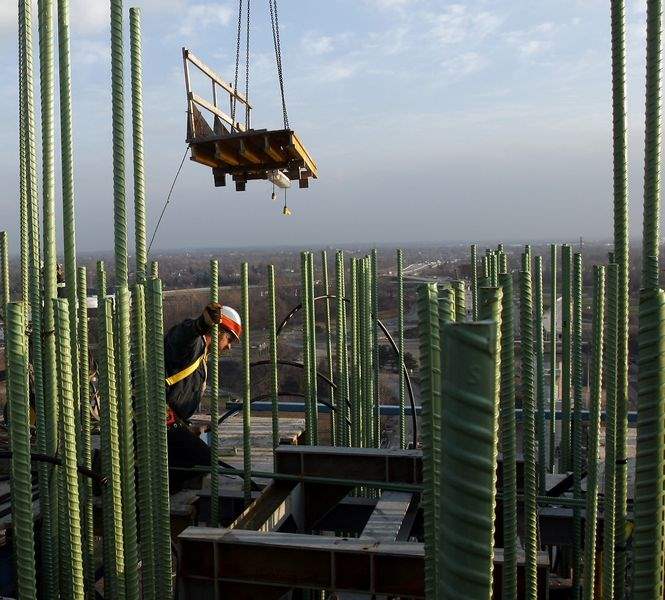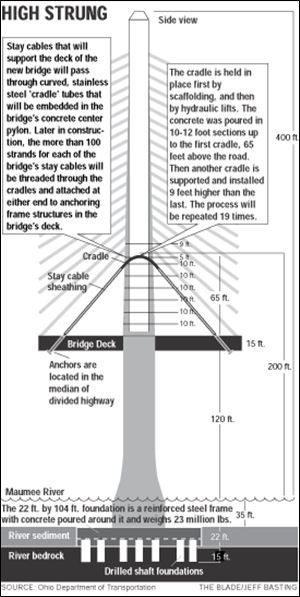
Bridge over the Maumee taking shape
12/7/2004
Doug Whiting of Fru-Con has a bird's-eye view of the surrounding area as he works atop a I-280 bridge pylon.
Wadsworth / Blade

Doug Whiting of Fru-Con has a bird's-eye view of the surrounding area as he works atop a I-280 bridge pylon.
Even on a calm day on the ground, it's usually windy 200 feet up. Just ask Gene Phelps.
As the center pylon for the I-280 Maumee River Crossing project has risen above the Maumee's waters, so has Mr. Phelps' workplace. As one of several surveyors on the project, it's his job to make sure every part of the tower, which eventually will stand 400 feet above the river, is exactly where it should be.
It's a job that will continue through the winter, but Mr. Phelps, a Pensacola, Fla., resident, said he's had two years on the local project to adjust to the icy weather here.
"It's cold, it's windy, but it's fun," said Mr. Phelps, who says he likes heights. Nonetheless, he said, "it's going to be a long winter."
Construction of the $220 million bridge's main roadway spans was halted by the Feb. 16 collapse of one of two massive, Italian-made truss cranes that killed four ironworkers and injured two other workers and two operating engineers. Within hours after work was finally cleared to resume again Oct. 23 using the second truss crane, an electrical wiring problem apparently resulted in one of the support legs snapping off its cable just behind workers in a nearby bucket crane. Work was again halted.
Meanwhile, work on other aspects of the project continues. As of Wednesday, the project was 75 percent complete, with general contractor Fru-Con Inc. of Ballwin, Mo., paid $172.9 million to date.
Mike Gramza, the Ohio Department of Transportation's construction manager for the project, said the casting yard making prefabricated concrete segments for the bridge spans is expected to finish production by February. Of 181 bridge piers, 177 are complete, with caps still to be added to three and the last involving replacement of a pier destroyed by the Feb. 16 collapse.
Mr. Phelps' work, and that of other surveyors, entered a new dimension last week when the first of 20 stainless steel cradles, through which supporting stay cables for the bridge's main span over the Maumee will pass, was hoisted into position atop the pylon's completed portion.

Getting the six-ton cradles positioned just right is critical to the project, and checking the work involves Mr. Phelps getting up on the pylon and other surveyors taking laser measurements from the banks of the Maumee River, hundreds of feet away.
The cradles are suspended in scaffolds and hoisted into place by the T-shaped crane at the pylon construction site. The scaffolds prevent the cradles from being set into their final positions, so hydraulic jacks are fitted under them. The scaffolds then are removed, and the jacks adjusted to position the cradles precisely.
After the first cradle was securely in place Friday, the next batch of concrete for the center pylon was poured around it. Once the concrete hardens, the surveyors will check once again to make sure the cradle didn't shift during the pour or the hardening.
The process will be repeated 19 times, with each cradle installed nine feet higher than the last.
On the outside, the cradles don't look like much more than curving pipes made of shiny metal. But inside the cradles are framing structures, called cheeseplates, and metal tubes through which each of the more than 100 strands in each stay cable will be threaded individually when the main bridge spans are built.
The cradles and their internal components will keep the steel stay cables from wearing down through the pylon or rubbing against each other.
As each cradle is installed and each batch of concrete is poured for the pylon - there are 21 "lifts" to go - another hydraulic jacking system pushes skyward the scaffolding structure upon which Mr. Phelps, a crew of ironworkers and operating engineers, and ODOT inspectors work.
The scaffolding is mounted on vertical beams with notches in them, resembling triple-track in storm windows, that allows the scaffold to go up, but not down. The scaffolding is reached by a tower of modular steel stairway that is built higher each time a new level is needed.
The workers on the bridge's center pylon will soon get some protection from winter's bitter winds by plastic sheeting to be hung from the scaffolding and portable heaters inside. Whenever the crane operators deem the wind to be dangerously strong, work will be suspended. But the crews still will need to dress warmly - the sheeting won't keep all the cold air out, and the dozens of flights of steps they climb and descend each day will remain exposed to the elements.
From their lofty perch, the workers can see the site of the fatal truss crane collapse in East Toledo. Most of them have applied stickers to their hard hats saluting the memories of their fallen colleagues.
"We think about the accident, but I don't think we dwell on it to the point that it affects our work," Mr. Phelps said.
Contact David Patch at:
dpatch@theblade.com
or 419-724-6094.